Accessible Miniature Golf - A Summary of Accessibility Guidelines for Recreation Facilities
United States Access Board
Accessible Miniature Golf: A Summary of Accessibility Guidelines for Recreation Facilities
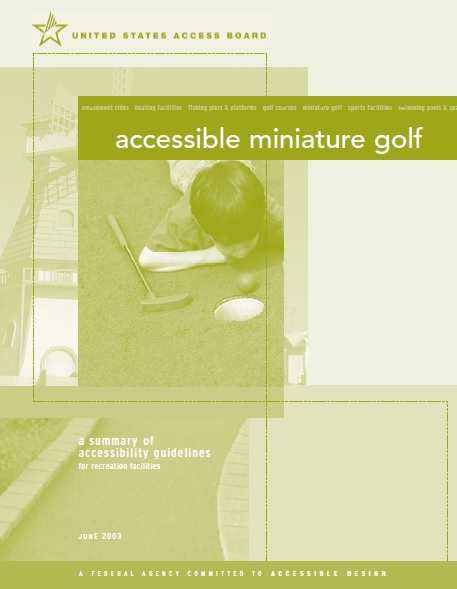
This information has been developed and reviewed in accordance with the Access Board’s information quality guidelines (www.access-board.gov/infoquality.htm).
Cover photo, bottom: Atlantic Miniature Golf
The products shown in this guide are only intended to serve as examples to illustrate the accessibility guidelines, and are not intended as endorsements of the products. Other products may be available. The Access Board does not evaluate or certify products for compliance with the accessibility guidelines. Users are advised to obtain and review product specifications for compliance with the accessibility guidelines.
Introduction
The Americans with Disabilities Act (ADA) is a comprehensive civil rights law that prohibits discrimination on the basis of disability. The ADA requires that newly constructed and altered state and local government facilities, places of public accommodation, and commercial facilities be readily accessible to, and usable by, individuals with disabilities. The ADA Accessibility Guidelines (ADAAG) is the standard applied to buildings and facilities. Recreational facilities, including miniature golf courses, are among the facilities required to comply with the ADA.
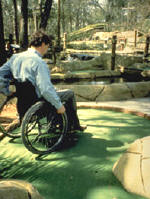
The Access Board issued accessibility guidelines for newly constructed and altered recreation facilities in 2002. The recreation facility guidelines are a supplement to ADAAG. As a supplement, they must be used in conjunction with ADAAG. References to ADAAG are mentioned throughout this summary. Once these guidelines are adopted by the Department of Justice (DOJ), all newly designed, constructed and altered recreation facilities covered by the ADA will be required to comply.
The recreation facility guidelines cover the following facilities and elements:
-
Amusement rides
-
Boating facilities
-
Fishing piers and platforms
-
Miniature golf courses
-
Golf courses
-
Exercise equipment
-
Bowling lanes
-
Shooting facilities
-
Swimming pools, wading pools, and spas
This guide is intended to help designers and operators in using the accessibility guidelines for miniature golf courses. These guidelines establish minimum accessibility requirements for newly designed or newly constructed and altered miniature golf courses. This guide is not a collection of miniature golf course designs. Rather, it provides specifications for elements within a miniature golf course to create a general level of usability for individuals with disabilities. Emphasis is placed on ensuring that individuals with disabilities are generally able to access the miniature golf course and use a variety of elements. Designers and operators are encouraged to exceed the guidelines where possible to provide increased accessibility and opportunities. Incorporating accessibility into the design of a miniature golf course should begin early in the planning process with careful consideration to accessible holes and accessible routes.
The recreation facility guidelines were developed with significant public participation. In 1993, the Access Board established an advisory committee of 27 members to recommend accessibility guidelines for recreation facilities. The Recreation Access Advisory Committee represented the following groups and associations:
-
American Ski Federation
-
American Society for Testing and Materials (Public Playground Safety Committee)
-
American Society of Landscape Architects
-
Beneficial Designs
-
City and County of San Francisco, California, Department of Public Works
-
Disabled American Veterans
-
Environmental Access
-
Golf Course Superintendents Association of America
-
Hawaii Disability and Communication Access Board
-
International Association of Amusement Parks and Attractions
-
Katherine McGuinness and Associates
-
Lehman, Smith, and Wiseman Associates
-
Michigan Department of Natural Resources
-
National Council on Independent Living
-
National Park Service
-
National Recreation and Park Association
-
New Jersey Department of Community Affairs
-
Outdoor Amusement Business Association
-
Paralyzed Veterans of America
-
Professional Golfer’s Association
-
Self Help for Hard of Hearing People
-
States Organization for Boating Access
-
Universal Studios
-
U.S. Army Corps of Engineers
-
U.S. Forest Service
-
Y.M.C.A. of the U.S.A.
-
Walt Disney Imagineering
The public was given an opportunity to comment on the recommended accessibility guidelines, and the Access Board made changes to the recommended guidelines based on the public comments. A notice of proposed rulemaking (NPRM) was published in the Federal Register in July 1999, followed by a five-month public comment period. Further input from the public was sought in July 2000 when the Access Board published a draft final rule soliciting comment. A final rule was published in September 2002.
Accessible Miniature Golf Courses
"Whenever any barrier stands between you and the full rights and dignity of citizenship, we must work to remove it, in the name of simple decency and justice. The promise of the ADA...has enabled people with disabilities to enjoy much greater access to a wide range of affordable travel, recreational opportunities and life-enriching services."
President George W. Bush, New Freedom Initiative, February 1, 2001
The recreation facility guidelines described in this guide focus on newly designed or newly constructed and altered miniature golf courses, adventure-style courses, and other putting courses. Other provisions contained in ADAAG address elements commonly found at a miniature golf course facility, such as accessible vehicle parking spaces, exterior accessible routes, and toilet and bathing facilities. ADAAG addresses only the built environment (structures and grounds). The guidelines do not address operational issues. Questions regarding operational issues should be directed to the Department of Justice, 1-800-514-0301 or 1-800-514-0383 (TTY).
Accessible Holes
At least 50 percent of the holes on a miniature golf course must be accessible—if possible, operators should make all holes accessible. Accessible holes must be consecutive, to offer a more socially integrated experience. If only the minimum number of holes are accessible, it is recommended that designers select holes that will offer golfers who use wheelchairs or other mobility devices a playing experience that is as equivalent as possible to the experience of golfers without disabilities. An exception permits courses to have one break in the sequence of accessible holes, if the last hole in the sequence is the last hole on the course. The route in which a golfer with a disability must travel may not require travel back through any holes, even if the route is adjacent to the hole and not on the hole itself.
Accessible Routes
Accessible routes are continuous, unobstructed paths connecting all accessible elements and spaces of a building or facility. The accessible route must comply with ADAAG provisions for the location, width (minimum of 36 inches), passing space, head room, surface, slope (maximum of 1:12 or 8.33%), changes in level, doors, egress, and areas of rescue assistance, unless otherwise modified by specific provisions outlined in this guide. The accessible route must connect the facility’s entrance with the first accessible hole and with start of play area on each following accessible hole. The course must be configured to allow an easy exit from the last accessible hole to the facility exit or entrance. When not all holes are accessible, a player cannot be required to double back through holes to exit. Where possible, designers and operators are encouraged to make all holes accessible. An accessible route connecting accessible holes may be on the hole-playing surface or adjacent to it.
Accessible Routes on the Playing Surface
The surface of the accessible route must be stable, firm and slip resistant. (Where carpets are used on the playing surface, they are not required to comply with the requirements in ADAAG for accessible carpets; however, they are still required to be stable, firm, and slip resistant.)
There is usually a curb around a hole to keep the ball within the area. When the accessible route is provided on the course, a 1-inch high maximum curb is permitted for an opening of 32 inches minimum where the accessible route extends outside the hole. This opening will permit passage of wheelchairs, while containing the ball within the hole. Designers should consider locating this opening in an area where the ball is not likely to roll.
The accessible route on a playing surface must be within 36 inches (the golf club reach range) of any area where the ball comes to rest.
Landings must be 48 inches long. Where ramps change direction, the landing size must be a minimum of 48 inches by 60 inches. The orientation of the length and the width have not been specified for added flexibility in design. Slopes on landings must be no more than 1:20 (5%).
If the accessible route is on the playing surface, handrails are not required. The accessible route may include a maximum slope of 1:4 (25%) for a maximum 4-inch rise. These steeper slopes or ramps are permitted for limited distances.
Accessible Routes Adjacent to the Playing Surface
If the accessible route is adjacent to the playing surface, it must not exceed 36 inches from any area where golf balls rest. This allows players to be close enough to reach the ball and play from outside the hole. The accessible route should be as close to the level playing areas as possible.
The accessible route adjacent to the playing surface must comply with ADAAG. The accessible route provisions in ADAAG address slope (maximum of 1:12 or 8.33%), width (minimum of 36 inches), cross slope (maximum of 1:50 or 2%), handrails, and changes in level.
Start of Play Areas
The clear floor or ground space area at the start of play for each accessible hole must be 48 by 60 inches minimum to allow players to position themselves for the first shot. It must have a slope no steeper than 1:48 so that people using wheelchairs or mobility devices do not have to hit the ball while positioned on a sloped surface. The accessible route and the clear space can overlap.

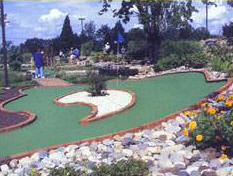
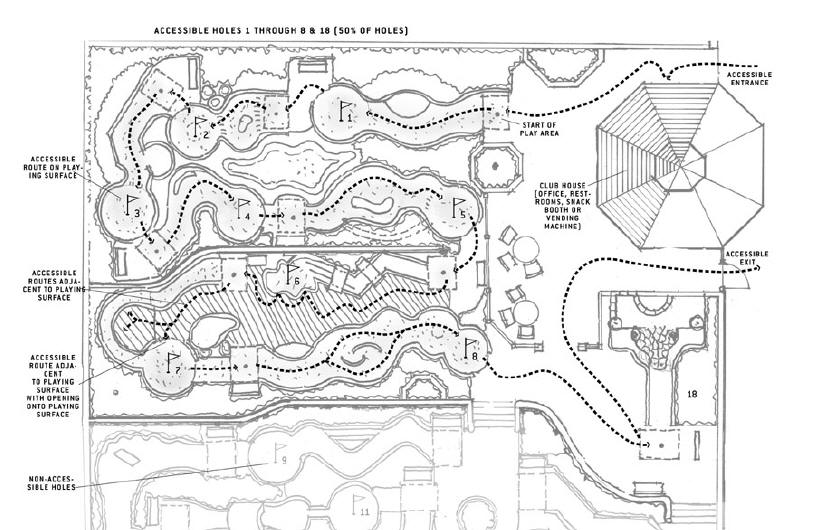
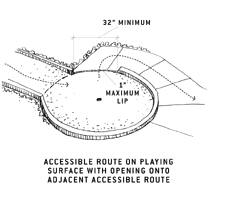
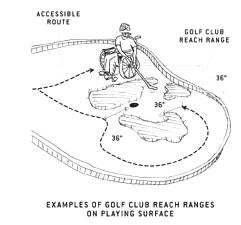
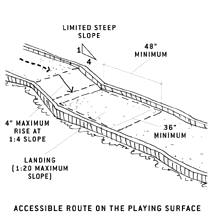
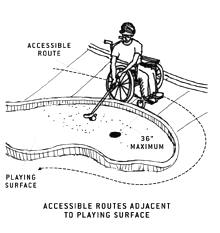
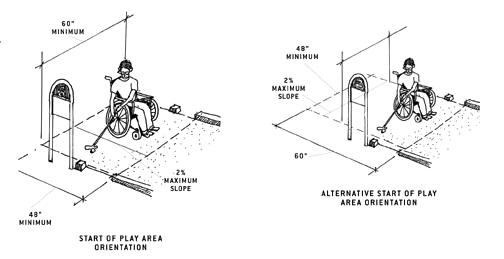
User Comments/Questions
Add Comment/Question